|
FAQs on Anemone Identification
30
Related Articles: Anemones,
Bubble
Tip Anemones, LTAs, Cnidarians, Coldwater Anemones, Colored/Dyed Anemones,
Related FAQs: Anemone ID 1, Anemone ID 2, Anemone ID 3, Anemone ID 4, Anemone ID 5, Anemone ID 6, Anemone ID 7,
Anemone ID 8,
Anemone ID 9, Anemone ID 10, Anemone ID 11,
Anemone ID 12,
Anemone ID 13, Anemone ID 14, Anemone ID 15, Anemone ID 16, Anemone ID 17, Anemone ID 18, Anemone ID 19, Anemone ID 20, Anemone ID 21, Anemone ID 22, Anemone ID 23, Anemone ID 24, Anemone ID 25, Anemone ID 26, Anemone ID 27, Anemone ID 28, Anemone ID 29, Anemone
ID 31, Anemone ID 32,
Anemone ID 33,
Anemone ID 34, Anemone ID 35, Anemone ID 36, Anemone ID 37, Anemone ID 38, Anemone ID 39, Anemone ID 40, Anemone ID 41,
Anemone ID 42,
Anemone ID 43,
Anemone ID 44, Anemone ID 45,
& Cnidarian Identification, Anemones 1,
Anemones 2, Anemones 3, Anemones
4, Anemones 5, Invertebrate Identification, Aiptasia
Identification, Aiptasia ID
2, LTA
Identification, Bubble Tip
Anemones, Caribbean
Anemones, Condylactis, Aiptasia
Anemones, Other Pest
Anemones, Anemones and
Clownfishes, Anemone
Reproduction, Anemone
Lighting, Anemone Feeding,
Anemone Systems,
Anemone
Compatibility, Anemone
Selection, Anemone
Health, Anemone Behavior,
Anemone
Placement,
|
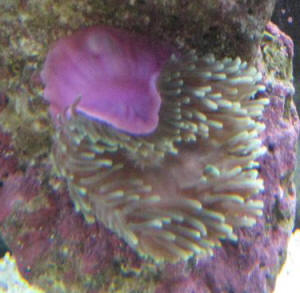
|
 |
New Print and
eBook on Amazon:
Anemone Success
Doing what it takes to keep Anemones healthy long-term
by Robert (Bob) Fenner
|
|
Anemone ID -- 08/14/09
I have the utmost respect for you, and I want to thank you in
advance for your expertise.
<Welcome>
I have a 65 gallon reef aquarium (18"x36"x24"
tall), and I have around 100 lbs of Fiji rock (it may be more
like 125 +, I have never measured its weight), and it is covered
in coral. I have enclosed several small photos of it today for
your convenience.
In my Fiji rock, I had a Valentine's Day Massacre Palythoa
colony growing into a hole, so I picked it out in order to
separate them, and when I did, an anemone began to show himself
again. Before they had begun growing in there, there was a baby
anemone growing, and it had died, I thought, but now it's
back.
What kind it is, I have no clue.
<Your pix are too blurry to tell>
It is blue, greyish blue and it's got fluorescent green tips
which look blue in the light and the tentacles are not very long
as of yet, but are growing by the day.
I honestly do not believe that this is aiptasia nor is it Majano
as I unfortunately know both really well, (bad experience,
eep).
<Neither of these in my estimation...>
However, I would like to try to identify it. It is directly
behind my pink pom pom pulsating xenia in the image and it is
approximately 1.5" across, but getting larger by the day. I
do have a Rose E. Quadricolor and a very large, LTA which
I've had for a year, and they are both very healthy and
happy, however when I got the Rose, its shipping mate arrived in
small chunks. I got them in January of 2009. Is there any chance
this is a baby E. Quad Rose which is now bleached from hiding
inside the Fiji under the Palys?
<Yes>
I also took a very short, very small video of the little fellow
and I can send that as well.
<Is it any clearer?>
I value your opinions and I want you to know that I left no leaf
unturned before I came to you with my question. I have literally
scoured your website looking for an anemone like this, and
unfortunately, I just can't tell.
Thanks in advance,
RPI
<Neither can I from these images. Bob Fenner>
|
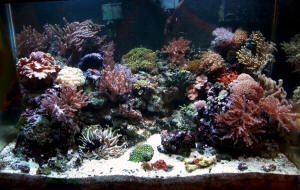 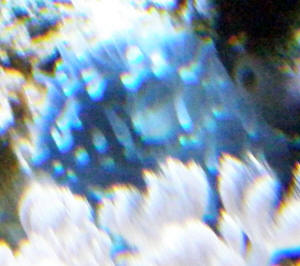
|
Re: Anemone ID
8/14/09
Dear Bob,
<RPI>
Thank you for your fast response. I am honored to have you
respond to my anemone inquiry.
<Glad to help where, when I can>
I have attached the video I took yesterday with the
camera.
<Nice, but no more informative than your stills... Is
there an easy way to move the animal in question away from
the Xeniid in front of it?>
It is a hair clearer. I think the thing is cute (notice the
majano behind it? Lol).
Thank you again,
RPI
<Methinks these other Cnidarians are working whatever
this is woe. Please read here:
http://wetwebmedia.com/cnidcompppt.htm
and the linked files above, particularly on Actinarian and
Xeniid Compatibility. BobF>
Re: Anemone ID
8/14/09
Hello and thanks for the advice regarding the overcrowding
issues in my aquarium. I am well aware and it's
heart-wrenching to think about clearing some paths but
it's got to be done.
<Yes>
With that said, the Xeniids in front of the little anemone
have been removed.
I have 2 new photos to send you of the little thing and
it's far smaller than I had originally thought. I had
written it was about 1.5" but, in actuality, it is
only 3/4" wide.
<I see... and see that this is much more likely a
Corallimorph. Please see here:
http://wetwebmedia.com/corallim.htm>
Thank you in advance for all this time and help...and I am
so grateful you are out there helping people like me who
have questions like this.
Here is the little guy again.
Thank you,
Renee
<Welcome. B>
|
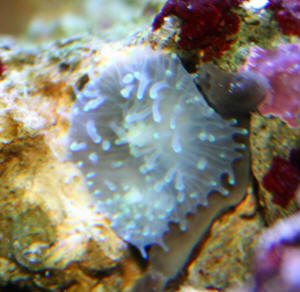 |
Re: Anemone ID 8/14/09
Thank you again,
<Welcome>
I recognize my coral overshot/crowding issues with
cnidarians. I am concerned as well. I just don't have
the heart to weed it all out. :o|
I will look into that today and will move the Xeniids to
get you a much clearer shot of the little anemone. Maybe it
will help give it room to come out as well.
Thanks again for your wonderful expertise.
RPI
<Glad to share. RMF>
Re: Anemone ID - Update 11/3/09
The little anemone Bob said he thought was a callimorph is
indeed a callimorph.
<A Corallimorph/arian... a "Mushroom Anemone"
I take it>
He is now about 1/2" in diameter, and he is a green
hairy mushroom.
Good job Bob!
WTG.
RPI
Pertaining to http://wetwebmedia.com/AnemID30.htm
<Be chatting. BobF>
|
|
|
Anemone ID 8/11/09
Hi Crew,
<Hello Sean>
I was hoping you might be able to identify this anemone for me.
It was sold to me as a Long Tentacle, but I'm now certain
that ID was incorrect.
<Appears so.>
Unfortunately, I've spent hours reading on WWM and searching
through pictures, but I'm not much closer to an accurate ID.
The pictures I've included don't accurately reflect the
colors of the anemone, but they should be close enough to get an
ID. My camera seems to have a hard time capturing true color with
my tank lights (150W 14K MH with T5 actinics).
<If your camera is capable, you may want to experiment with
the white balance control.>
Under normal lighting, the anemone has a red/orange foot,
tentacles that vary from cream to beige to green
(depending on lighting and inflation) with purple tips. I'm
thinking maybe a Heteractis species?
<Mmm, not enough tentacles for this specie. With the anemone
not fully inflated makes it a little tougher to ID, but likely
what you have is a specie of Condylactis, most coming from the
tropical West Atlantic, although there are Indo Pacific
species.>
I'm a bit concerned for this nem, as it is a bit small (maybe
2 1/2 inches across, fully inflated) and my A. Percula has
decided to host it. The anemone has been moving about, trying to
avoid the clown,
<Not the reason, the anemone is looking for a spot to it's
liking and will not fully inflate, remain stationary, until
found.>
and has ended up behind my rock work, where it isn't getting
light, and I can't get food to it, even with a turkey baster.
Any suggestions?
<Will not take food until fully inflated. I would not worry
too much about feeding right now, as anemones, under correct
lighting, will produce most of the nutrition they need to
survive. What are your water parameters, tank size, flow rate,
etc.?
Do read here and related articles on anemone care.
http://www.wetwebmedia.com/marine/inverts/cnidaria/anthozoa/anemones.htm>
Thanks in advance,
<You're welcome. James (Salty Dog)>
Sean
|
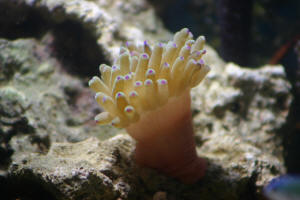 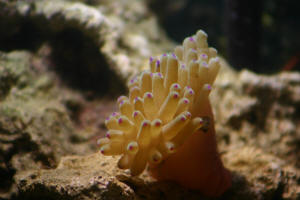 |
|
Re Anemone ID 8/12/09
Hi James,
<Sean>
My tank is a 20 long.
<Too small a volume to have any success with anemones.>
I have 150 watts of 14k metal halide with 2, 24 inch T5 actinic
tubes over it. I have approx. 1000 gph flow, provided by 2
powerheads, a Koralia 1, and a HOB refugium (DIY). My tank
contains about 22 pounds of live rock and a 1/2 inch sugar fine
sand bed.
Water parameters are as follows:
sg:1.026
temp: 78-80
pH: 8.6
dKH: 11
Calcium: 450
Ammonia, nitrite, and nitrate all read 0 when tested this
afternoon.
Inhabitants include a Percula clown, a yellow watchman goby, and
2 green chromis.
<The goby and chromis' will be at risk with a healthy
anemone.>
Clean up crew consists of Nassarius and Cerith snails. I have a
few corals in my tank as well (I know, I know...) which include
Zoanthids, Clove Polyps, a small Goniopora, a couple of heads of
Frogspawn, and a couple of SPS frags.
The anemone has been in my tank for almost a month. It seemed
very happy and stayed put until my clown started hosting it. Any
clue what caused it to go wandering?
<Mentioned that in the previous post, and as above. James
(Salty Dog)>
Sean
|
|
Identification Question/Aiptasia 8/10/09
Hello everybody at WWM,
<Hi Jeff>
I have an identification question. I have this creature that
looks like a stringy version of an sea anemone (picture
attached)... never bought him/her they just "showed"
up. They have been multiplying ever since.
What is this thing and is it safe to have with my Yellow
Boxfish?? Are they known to extrude things into the water? (I
think they've been mating and making the water cloudy time to
time) Thanks,
<What you have are aiptasia, and not good to have in your
system.
Do read/learn about this dreaded pest here.
http://www.wetwebmedia.com/marine/inverts/cnidaria/anthozoa/aiptasia/aiptasia.htm
http://www.wetwebmedia.com/ca/volume_1/cav1i3/aiptasia_impressions/aiptaisia_impressions.htm
James (Salty Dog)>
Jeff
|
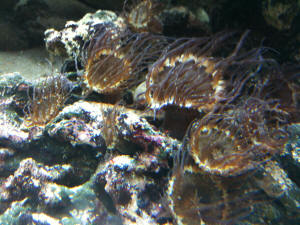 Nice pic! RMF Nice pic! RMF |
|
anemone identification 8/2/09
Greetings,
<Howdy>
I've recently acquired a rock from the Gulf of Mexico (Texas
coast). It came with 8-9 anemones attached to it. I would like to
know the species so that I know if they need special care. I have
attached two pictures. One shows the fantastic color and the
other shows the knobby base. I'm leaning toward a warty
anemone, but I can't find a picture of one that looks like
these. Please help!
Y'all guys are great!
thanks,
<Have looked about in my ref.s, the Net and I don't see
anything like this as occurring from the Gulf or TWA... Will post
on WWM with the hope it is familiar to someone browsing... Bob
Fenner>
|
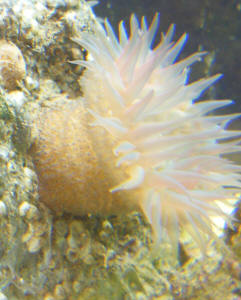 |
Need help identifying an anemone
8/3/09
Hi,
Y'all guys are awesome, so maybe you can help me out. I have
been trying to get a concrete id on an anemone for a couple of
weeks and have been getting answers that range from insane to maybe
plausible. I decided to ask the guru! I know these anemones came
from the gulf coast on the Texas shore. I
am leaning toward a warty, but the tentacles look wrong to me. The
"fish crowd" in a forum I frequent insit that they are
rock anemones, but the pics they point me toward don't have the
severe knobbing on the base like these do. I would like to know the
scientific name and basic care/light needs of these guys. They have
awesome color and I would like for them to thrive.
Any help would be appreciated.
thanks so much
<I still don't know... BobF> |
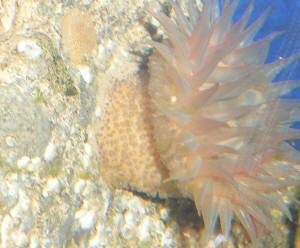 |
|
Re: anemone identification -- 08/04/09
Thanks so much. I really curious as to what these guys are.
Renea Bosley
<Me too! I was out at Port Aransas two weekends back... and
friends were collecting something similar on the rocks... but,
what is it? BobF>
Re: anemone identification -- 08/04/09
I have the marine biology dept. at the Texas Aquarium working on
it.
Hopefully will have an answer this afternoon.
Renea Bosley
<Ahh! I thank you, BobF>
Re: anemone identification 8/5/09
Here is the response I got back from Jeff. He is with the Dallas
aquarium:
Arden passed your inquiry along to me. The species of anemone
from the photos appears to be a Warty rock anemone (/Bunodosoma//
sp/). The blue "warts" on the column are the tell tale
sign. The photo showing the oral disc and tentacles confused me
until I realized the tentacles are somewhat retracted in the
photo, giving them the appearance of a different anemone.
Many colors and patterns exist in the Warty rock anemone,
everything from pink and yellow to red and green. These anemones
are quite common on the gulf coast near Galveston, especially in
tide pools. These anemones typically do better in cooler water,
somewhere around 75F and the warmer than usual water could be the
reason for the slight tentacle retraction in the photo. I hope
this helps answer your question.
Bunodosoma cavernata
Not an absolute answer, but pretty darn close.
Renea Bosley
<Thanks much Renea! BobF>
|
|
Anemone ID, thanks to JoshS 7/30/09
Hello again!
<Hi there Jake>
This is my second email and just wanted to thank Josh Solomon for
his advice on my shrimp goby/pistol shrimp pair. (They have
bonded as of last Friday! They reappeared together and are SO
interesting to watch! I've been late to work this whole week
because I get caught up watching them.)
<I'll send along your thanks, oh! And see Josh et al. at
the IMAC conf. this wknd>
On to my anemone question though and I'm sorry if I wasted
some valuable time. I asked the LFS to order a Bubble Tip Anemone
that was either neon green or white and this is what I got.
<Mmmm... this is a Heteractis magnifica... much harder to
keep...>
Needless to say this doesn't look like the BTA I've seen
online or in this store. If I could get an ID it would be greatly
appreciated.
Thanks,
Jake
PS: You guys are awesome and so is your website!
<Thanks. Please read here:
http://wetwebmedia.com/marine/inverts/cnidaria/anthozoa/hetmagnifica.htm
and the linked files above... Bob Fenner>
Re: anemone identification -- 08/06/09
Bob,
I just got back some more info from the Aquarium that I find very
interesting, maybe the readers will also. It contradicts
mush of what the "mainline" school of thought is on
keeping multiple anemones. I have posted the
email....
<<Thank you again Renea. Please see my comments below as
well. Bob Fenner>>
I think the heat is definitely playing a role in the lack of
tentacle expansion with these anemones. Any severe temperature
swings, especially those that last for extended periods of time,
will undoubtedly cause at
very least some discomfort to any aquatic life and especially in
sessile invertebrates. I would definitely "force"
myself back down to the coast to take a look. I would bet there
would be a noticeable difference in tentacle appearance after the
temps have been back down to normal for a few weeks.
Anemones will naturally live in clusters.
<<Mmm, not so... most of the large species of Actinarians
involved in symbiotic relationships with Amphiprionines are
solitary... Heteractis magnifica is sometimes found in
associations, and rarely H. crispa...
However there are other, "social" species of anemones
assuredly>>
A few peeks at some of the more dominate reefs of the world will
show many anemones, especially pacific varieties living in very
close proximity and often time touching each other. In an
aquarium setting, I wouldn't worry about allelopathy
(chemical warfare) between the anemones. This is a much more
common occurrence with soft corals (Cladiella sp, Sarcophyton sp,
etc). These soft corals lack the powerful nematocysts (stinging
cells usually used in prey capture) of anemones, so they will
release terpenes
into the water to injure or kill other corals competing for
space. Anyway, back to the anemones. As long as they are the same
species, the nematocysts will not recognize the each other and
will not fire; therefore being able to live in very close
proximity without any issues.
<<I have found this to not be so... or else some other
explanation is lacking in my consciousness. Rather than species,
the genetic "closeness" to the point of being clones IS
of import... I worked a bit with
Anthopleura elegantissima and A. gigantea years back in college
re the issue. You are welcome to fwd my input to Jeff.
RMF>>
There is a very interesting theory closely tied to this with the
Clownfish/anemone relationship, but that's something for a
different time.
Now, if the anemones were of different species there would be a
major "war" going on between the two, but it would be
all physical response passed through the nematocysts of the
differing species of anemones causing them to sting (in a
predator/prey response) repeatedly until one of them moves or
dies.
Hopefully this helps answer your questions. If you have any
further questions, feel free to contact me. I will do my best to
answer them for you.
Thanks again,
Jeffrey Gall
Education coordinator
The Dallas World Aquarium
Re: anemone identification -- 08/06/09
Bob,
Thanks for your input.. It's amazing how much information I
have gained from a quick weekend get-away at the beach and
curiosity about an (at the time) unknown anemone.
You guys are great!!!
Renea Bosley
<We'll see...! BobF>
|
 |
|
|

